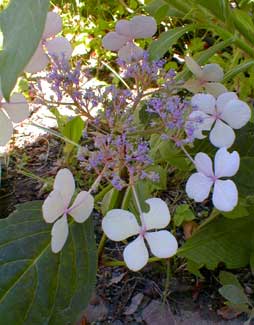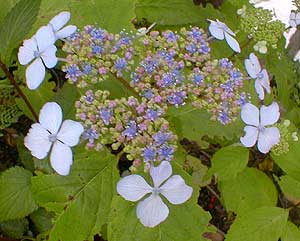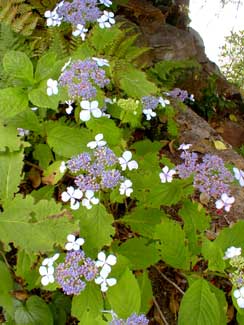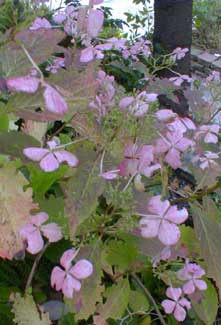
'Bluebird'
Lacecap Hydrangea, or
Mountain Hydrangea, or
Sawtooth Hydrangea
"Shadowy hydrangeas reached & swung
Ferociously; & over me, among
The moths & mysteries, a blurred bat flew."
-Edwin Arlington Robinson
(1869-1935)
(1869-1935)
The Sawtooth Hydrangea (H. serrata) is sometimes listed as a subspecies of Bigleaf Hydrangea (H. macrophylla). It is smaller & more cold-hardy than Bigleaf Hydrangea, & is more properly permitted its own species status.
The specific cutting-propagated cultivar 'Bluebird' (or 'Blue Bird') is an heirloom shrub developed long ago in Japan from a Korean variant, H. serrata forma acuminata, the Mountain Hydrangea.
 In 1960, 'Bluebird' was honored by the Royal Horticultural Society with the Award of Garden Merit. It often remains in the three by four foot range as a mature shrub, but its ten-year size can be as much five or six feet height, & a full six feet width.
In 1960, 'Bluebird' was honored by the Royal Horticultural Society with the Award of Garden Merit. It often remains in the three by four foot range as a mature shrub, but its ten-year size can be as much five or six feet height, & a full six feet width.Although that size does not exactly constitute a small shrub, it is smaller than Bigleaf Hydrangea, hence more suited to smallish gardens. It can over time get bigger still, but as it requires annual pruning to bloom well, the size is easily kept restrained.
 It blooms as long as from June to November without interruption, July through August certainly. The lacecap is made up of a center of tiny dark blue fertile flowers, surrounded by large sterile petals of palest bluish-purple. It is bluer in acidic soil than alkaline, but it's fairly blue in any soil condition. As insects pollinate the fertile flowers of the center, they turn their petals to reveal pinker reverse side.
It blooms as long as from June to November without interruption, July through August certainly. The lacecap is made up of a center of tiny dark blue fertile flowers, surrounded by large sterile petals of palest bluish-purple. It is bluer in acidic soil than alkaline, but it's fairly blue in any soil condition. As insects pollinate the fertile flowers of the center, they turn their petals to reveal pinker reverse side.Occasionally listed as a vine, it's hard to imagine this compact rounded shrub as a vine, but the main stems do often bend & twist. If it were trained to an espalier beginning when still small in size, it could be given to the appearance of a six foot tall climber. Growth rate is moderate to rapid.
The first three photos from June & July of different years show the usual color. The fourth photo is from November, showing the last drying "remnant" flowers after the large sterile blooms around the fertile lacecap have turned a very pretty shade of lavender, & still extremely pretty. By December latest, these lacecaps will turn brown, & can still be attractive.
 Pruning can be done for an ideal shape when it is finished flowering in autumn. But pruning to strengthen flowering should be done in late winter or early spring, with the cuts being defined by the location of fattening buds. The previous years' flowers which dry on the branches can be left through winter for their own moderate ornamental interest. Deadheading can wait until spring, & at the same time, prune each flowering stem back to the first pair of large buds.
Pruning can be done for an ideal shape when it is finished flowering in autumn. But pruning to strengthen flowering should be done in late winter or early spring, with the cuts being defined by the location of fattening buds. The previous years' flowers which dry on the branches can be left through winter for their own moderate ornamental interest. Deadheading can wait until spring, & at the same time, prune each flowering stem back to the first pair of large buds.At the same time, while spring-pruning 'Bluebird,' it can be beneficial to underlimb a bit, removing some of the snaky straggling branches that grow outward from the bottom. This will increase the upright growth & keep it from wasting too much energy on weaker or creeping bottom-branch blossoms that get bug-eaten on the ground.
Like most heavy bloomers, the shrub will need regular feeding to bloom its best, a good spring fertilizing minimally & perhaps a couple more times throughout the year.
Full shade may not be the best thing for it. It will do well in full sun if the soil never dries out, & it will do best in partial shade & even become drought-hardy therein.
Although the pale blue flowers can be caused to be somewhat pink-hued with a more alkaline soil, really the shrub prefers acidic well-draining soil, & tinkering with the pH to change the flower color can stress a shrub.
Its ideal pale blue coloration is so remarkable that if one wishes to experiment with pH responses for different colored blooms, a "snowball" variety of Bigleaf Hydrangea would be a better choice than 'Bluebird' Mountain Hydrangea.
Although snowball hydrangeas (meaning doubles with only the large sterile flowers) are kind of a standard shrub in Northwest landscapes, I always find them to be gaudy & tasteless. But if one really does wish to see how tinkering with soil pH can cause the blooms to develop pink in alkaline, white in neutral, & blue in acidic ground, the gaudy doubles are the way to go.
My personal preference for the lacecap flowers is not across-the-board, as some lacecaps are too plain & can look like greenish buds that never quite finish developing at the center. But in the case of 'Bluebird,' the little fertile center petals are so rich a shade of blue-violet, they'd be gorgeous even without the additional ruffle of large sterile petals.
Foliage turns coppery red to burgundy in autumn. Foliage color is best on shrubs that are positioned in more sun, but flowers fade more prettily in autumn & last longer in dappled sunlight or partial shade.